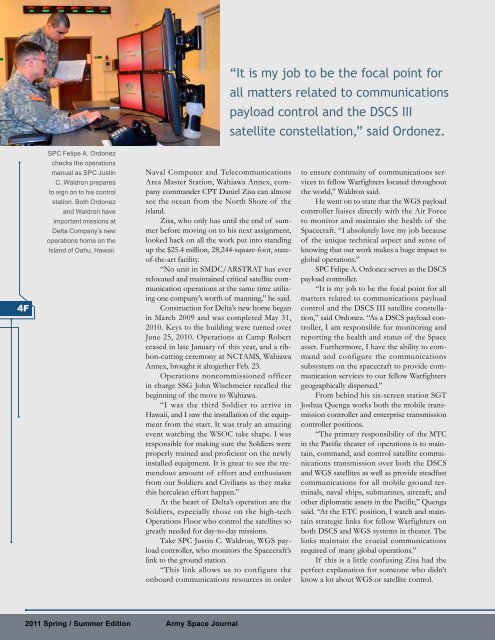Spring 2011 - Space and Missile Defense Command - U.S. Army
Spring 2011 - Space and Missile Defense Command - U.S. Army
Spring 2011 - Space and Missile Defense Command - U.S. Army
You also want an ePaper? Increase the reach of your titles
YUMPU automatically turns print PDFs into web optimized ePapers that Google loves.
“It is my job to be the focal point for<br />
all matters related to communications<br />
payload control <strong>and</strong> the DSCS III<br />
satellite constellation,” said Ordonez.<br />
SPC Felipe A. Ordonez<br />
checks the operations<br />
manual as SPC Justin<br />
C. Waldron prepares<br />
to sign on to his control<br />
station. Both Ordonez<br />
<strong>and</strong> Waldron have<br />
important missions at<br />
Delta Company’s new<br />
operations home on the<br />
Isl<strong>and</strong> of Oahu, Hawaii.<br />
4F<br />
Naval Computer <strong>and</strong> Telecommunications<br />
Area Master Station, Wahiawa Annex, company<br />
comm<strong>and</strong>er CPT Daniel Zisa can almost<br />
see the ocean from the North Shore of the<br />
isl<strong>and</strong>.<br />
Zisa, who only has until the end of summer<br />
before moving on to his next assignment,<br />
looked back on all the work put into st<strong>and</strong>ing<br />
up the $25.4 million, 28,244-square-foot, stateof-the-art<br />
facility.<br />
“No unit in SMDC/ARSTRAT has ever<br />
relocated <strong>and</strong> maintained critical satellite communication<br />
operations at the same time utilizing<br />
one company’s worth of manning,” he said.<br />
Construction for Delta’s new home began<br />
in March 2009 <strong>and</strong> was completed May 31,<br />
2010. Keys to the building were turned over<br />
June 25, 2010. Operations at Camp Robert<br />
ceased in late January of this year, <strong>and</strong> a ribbon-cutting<br />
ceremony at NCTAMS, Wahiawa<br />
Annex, brought it altogether Feb. 23.<br />
Operations noncommissioned officer<br />
in charge SSG John Wischmeier recalled the<br />
beginning of the move to Wahiawa.<br />
“I was the third Soldier to arrive in<br />
Hawaii, <strong>and</strong> I saw the installation of the equipment<br />
from the start. It was truly an amazing<br />
event watching the WSOC take shape. I was<br />
responsible for making sure the Soldiers were<br />
properly trained <strong>and</strong> proficient on the newly<br />
installed equipment. It is great to see the tremendous<br />
amount of effort <strong>and</strong> enthusiasm<br />
from our Soldiers <strong>and</strong> Civilians as they make<br />
this herculean effort happen.”<br />
At the heart of Delta’s operation are the<br />
Soldiers, especially those on the high-tech<br />
Operations Floor who control the satellites so<br />
greatly needed for day-to-day missions.<br />
Take SPC Justin C. Waldron, WGS payload<br />
controller, who monitors the <strong>Space</strong>craft’s<br />
link to the ground station.<br />
“This link allows us to configure the<br />
onboard communications resources in order<br />
to ensure continuity of communications services<br />
to fellow Warfighters located throughout<br />
the world,” Waldron said.<br />
He went on to state that the WGS payload<br />
controller liaises directly with the Air Force<br />
to monitor <strong>and</strong> maintain the health of the<br />
<strong>Space</strong>craft. “I absolutely love my job because<br />
of the unique technical aspect <strong>and</strong> sense of<br />
knowing that our work makes a huge impact to<br />
global operations.”<br />
SPC Felipe A. Ordonez serves as the DSCS<br />
payload controller.<br />
“It is my job to be the focal point for all<br />
matters related to communications payload<br />
control <strong>and</strong> the DSCS III satellite constellation,”<br />
said Ordonez. “As a DSCS payload controller,<br />
I am responsible for monitoring <strong>and</strong><br />
reporting the health <strong>and</strong> status of the <strong>Space</strong><br />
asset. Furthermore, I have the ability to comm<strong>and</strong><br />
<strong>and</strong> configure the communications<br />
subsystem on the spacecraft to provide communication<br />
services to our fellow Warfighters<br />
geographically dispersed.”<br />
From behind his six-screen station SGT<br />
Joshua Quenga works both the mobile transmission<br />
controller <strong>and</strong> enterprise transmission<br />
controller positions.<br />
“The primary responsibility of the MTC<br />
in the Pacific theater of operations is to maintain,<br />
comm<strong>and</strong>, <strong>and</strong> control satellite communications<br />
transmission over both the DSCS<br />
<strong>and</strong> WGS satellites as well as provide steadfast<br />
communications for all mobile ground terminals,<br />
naval ships, submarines, aircraft, <strong>and</strong><br />
other diplomatic assets in the Pacific,” Quenga<br />
said. “At the ETC position, I watch <strong>and</strong> maintain<br />
strategic links for fellow Warfighters on<br />
both DSCS <strong>and</strong> WGS systems in theater. The<br />
links maintain the crucial communications<br />
required of many global operations.”<br />
If this is a little confusing Zisa had the<br />
perfect explanation for someone who didn’t<br />
know a lot about WGS or satellite control.<br />
<strong>2011</strong> <strong>Spring</strong> / Summer Edition <strong>Army</strong> <strong>Space</strong> Journal
















